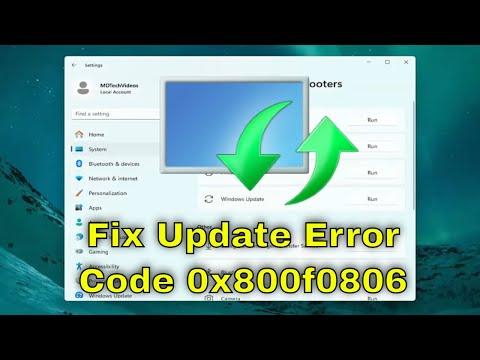I remember the day I encountered the error code 0x800f0806 on my Windows 11 computer like it was yesterday. It all started when I attempted to update my system to the latest build. I had been working on a crucial project, and updating the operating system was essential to ensure compatibility with new software. As I initiated the update process, I was confident that it would go smoothly, but suddenly, I was met with an error message that read “Update Error Code 0x800f0806.”
At first, I was puzzled. This error code wasn’t something I had seen before, and its cryptic nature made it even more frustrating. I decided to do some research to figure out what went wrong. The error code 0x800f0806 is often associated with issues in the update components or corrupt files. After some digging, I learned that this error could be triggered by a variety of underlying problems, such as missing or corrupted system files, issues with the update cache, or even conflicts with other software on my computer.
Determined to resolve the issue, I started with the basics. The first step was to restart my computer. Sometimes, a simple reboot can resolve minor glitches and conflicts that might be causing the update to fail. After the restart, I tried to update again, but unfortunately, the error persisted.
Next, I decided to check the Windows Update Troubleshooter. This built-in tool is designed to identify and automatically fix issues related to Windows Update. To access it, I went to the Settings app, then to System, and clicked on Troubleshoot. From there, I selected Other troubleshooters and ran the Windows Update Troubleshooter. It detected a few problems and attempted to fix them, but the error code 0x800f0806 still appeared.
Undeterred, I turned to the System File Checker (SFC) tool. This tool scans for and repairs corrupted system files that could be causing the update to fail. I opened Command Prompt with administrative privileges and entered the command sfc /scannow. The scan took some time, but it eventually finished and reported that it had repaired some corrupted files. I restarted my computer once more and tried the update again, but the issue remained unresolved.
Realizing that the problem might be related to the Windows Update components, I decided to manually reset these components. I opened Command Prompt as an administrator again and proceeded with the following steps:
- I stopped the Windows Update services by typing
net stop wuauservand pressing Enter. - I also stopped the Background Intelligent Transfer Service by typing
net stop bitsand pressing Enter. - Next, I navigated to the
C:\Windows\SoftwareDistributionfolder and deleted its contents. This folder stores temporary update files, and clearing it can sometimes resolve update issues. - After that, I restarted the Windows Update services by typing
net start wuauservandnet start bits, respectively, and pressing Enter.
After completing these steps, I tried to update my system again. To my relief, the update process started and eventually completed successfully. However, I knew that dealing with update errors might not be a one-time occurrence. So, I took some preventive measures to ensure smoother updates in the future.
First, I made sure my system was up to date with the latest drivers and firmware. Sometimes, outdated drivers can cause conflicts during the update process. I visited the device manufacturer’s website and downloaded the latest drivers for my hardware components. I also checked for firmware updates and applied them if available.
Second, I ensured that my system had sufficient disk space. Sometimes, updates fail simply because there isn’t enough space on the system drive to accommodate the update files. I cleaned up unnecessary files and uninstalled applications I no longer needed, which freed up valuable space.
Finally, I made it a habit to regularly back up my system. Although it wasn’t directly related to the error code 0x800f0806, having a recent backup can be a lifesaver if anything goes wrong during the update process or if I encounter other issues in the future.
In summary, encountering the update error code 0x800f0806 was a frustrating experience, but through a combination of basic troubleshooting steps, manual resets, and preventive measures, I was able to resolve the issue and ensure my Windows 11 system remained up to date. It was a valuable learning experience that highlighted the importance of staying informed about system maintenance and troubleshooting techniques.
